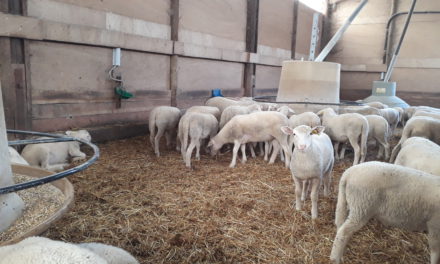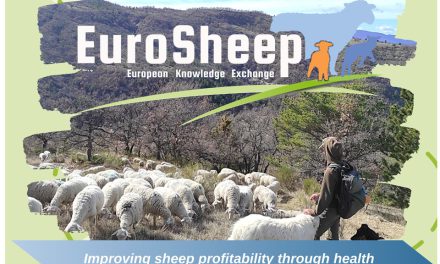This post is also available in:
![]()
![]()
![]()
Knowledge of Nutrition Requirements for Fattening Lambs
Theoretical approach: what are the energy and protein needs of lambs post-weaning?
Lambs nutritional requirements can be differentiated in 2 categories: maintenance (based on their liveweight and environment), and growth (based on their expected performance).
Energy needs
The energy requirements for fattening lambs can be expressed:
- In the INRAE 2018 French system, as ‘Unité Fourragère Viande’, where 1UFV is the energy value of 1 kilogramme of reference barley (or 1760kcal of Net Energy),
- as MJ/d in the AFRC United Kingdom’s system.
For INRAE 2018 system, the energy needs for maintenance is 0.018 UFV/kg of liveweight. The energy needs for 1kg of growth is 2UFV. This means that if a lamb has a daily weight gain of 250g/d, its daily energy needs for its growth are 0.5 UFV.
For the AFRC system, the metabolizable energy requirements of growing castrated lambs on forage are synthetised in the table below:
|
Lamb Weight (kg) |
Growth Rate (g/day) |
Potential dry matter intake (kg DM/day) |
Metabolisable energy (MJ/day) |
|
20 |
250 |
0.8 |
10 |
|
30 |
250 |
1.2 |
13 |
|
40 |
250 |
1.6 |
16 |
Metabolisable Protein
The protein needs of lambs are expressed:
- In INRAE 2018 system, in PDI (Protéines Digestibles dans l’Intestin grêle)
- In the AFRC system as Metabolisable Protein (MP).
In the INRAE 2018 system, the protein needs for maintenance is about 1.6PDI/kg of liveweight. The protein needs for 1kg of growth is 267g of PDI. For a lamb with a daily weight gain of 250g/d, its protein needs are 67g of PDI.
For the AFRC system, the metabolizable proteins requirements of castrated lambs on a diet with M/D of 12 MJ/kg DM are synthetised in the table below:
|
Lamb Weight (kg) |
Growth Rate (g/day) |
Potential dry matter intake (kg DM/day) |
Metabolisable protein (g/day) |
|
20 |
250 |
0.8 |
110 |
|
30 |
250 |
1.2 |
114 |
|
40 |
250 |
1.6 |
119 |
In a diet that is not limiting for protein, lambs with higher needs are able to recycle some of the unused proteins.
Intake
In diets rich in concentrates, where the feeds are given ad lib, the ingested dry matter will vary according to the lamb growth. With these diets, lambs have a metabolic regulation which allows them to reduce their intake to maintain a constant energy intake; and not a physical regulation linked to the ration size.
In practice: ideal nutritional values for feeds given to lambs in shed
In order to have the best value for money feed formulation, which provide good growth, correct intake and good carcass quality, we have defined some ideal feeds values for a balanced diet with concentrates. This concentrates ration must of course be added to roughage such as straw or hay for a good rumen function.
The proposed values are as follows :
- Energy values : between 0.9 and 1 UFV per kg brut (fresh weight) or, in Megajoules: between 10.3 and 11.4 per kg FW or 11.9 – 13.2 per kg Dry matter.
For diets rich in concentrates, the lamb regulates it consumption according to the energy value of the feeds (metabolic regulation). The more energy-rich the feeds, the less daily intake. The energy value of these feeds vary between 0.85 and 1.05 UFV (9.7 -12.0 MJ of ME (FW) or 11.2 -13.9 MJ of ME (DM)) . To compare feeds, it is important to look at the cost/UFV. If both feeds have the same protein content, then the feed with the cheapest UFV is interesting.
- Metabolisable Protein : 100 g of PDI per kg brut
The protein needs are expressed as PDI (protéines digestibles dans l’intestin grêle). Feeds with 100 g of PDI per kg brut have the same growth results than those with 110 g or 120 g of PDI.
- Proteins in the AFRC system: when formulating to Metabolisable Proteins requirements use the feed components FME (fermentable metabolisable energy), ERDP (effective rumen degradable protein) and DUP (digestible undegraded protein) of each feed in the diet to work out MP supply. For a standard fattening lamb mix the overall crude protein should be 14- 16 % (as fed) ad libitum.
- Minerals and vitamins:
These elements must be balanced according to the feeds used. In a high concentrate ration urinary lithiasis is more of a risk in male lambs due to availability of phosphorous therefore the recommended Ca:P ratio is 2:1; ideally nearer to 3:1 in at risk breeds such as texels. Magnesium should be less than 2.3 g/kg DM. Adding 0.5% ammonium chloride limits the risks of urinary lithiasis. The additive is forbidden in organic systems. Additional measures include ensure good access to water and including 1,5% salt in the ration (total Na around 6 g/kg DM).
Topic: nutrition
Production: Dairy
Animal Category: Lambs
Implementation
These feeds values can be obtained by mixing your own feeds or buying commercial ones. For the commercial feeds, these values are not always displayed or provided, so ask your feed representative to give them to you. Concentrates must be given with roughage (straw or coarse hay) to guarantee a good fibres intake and optimum rumen function.
Expected benefits
To get the best compromise between feed costs, consumption index or intake, and carcass quality.
Prerequesites and/or limits
These protein levels are only advised for lambs with high growth potential.







